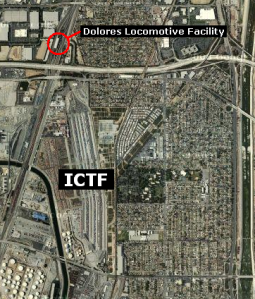 Click for larger map of the area. (Google Maps)Tucked in and nestled amongst the refineries and processing facilities of Long Beach, California and adjacent to the interchange of Interstate 405 and 710, lies Union Pacific’s Intermodal Container Transfer Facility or ICTF. This 233 acre facility is a keystone component in Union Pacific’s intermodal business and provides a very valuable service to the shipping companies that dock at the Ports of Long Beach and Los Angeles. A good portion of the shipping containers that are destined for locations in the interior regions of the United States are transferred to trains at the ICTF. It is quite an amazing beehive of activity to behold.
Click for larger map of the area. (Google Maps)Tucked in and nestled amongst the refineries and processing facilities of Long Beach, California and adjacent to the interchange of Interstate 405 and 710, lies Union Pacific’s Intermodal Container Transfer Facility or ICTF. This 233 acre facility is a keystone component in Union Pacific’s intermodal business and provides a very valuable service to the shipping companies that dock at the Ports of Long Beach and Los Angeles. A good portion of the shipping containers that are destined for locations in the interior regions of the United States are transferred to trains at the ICTF. It is quite an amazing beehive of activity to behold.
History
Container use for freight transportation in the United States began as early as the 1950s when the US Department of Defense drafted specifications for containers to be used for transporting military cargo. In the 1960s, US railroads began adopting the use of containers as a viable means of transporting cargo that also afforded other significant efficiencies and benefits to include:
- Reduce freight handling times (Containers go right from the ship to a truck and or a rail car and vice-versa)
- Increased security
- Reduced loss due to damages and handling
- Faster load and unload times
It wasn’t until the 1980s that true “intermodal” use of the containers caught on and started supplanting the manifest train and became the most prevalent train seen on the mainline of US railroads. Today, outside of bulk cargo (i.e. Coal, petroleum, grains, etcetera), most “goods” travel by container. Therefore, the US railroads are becoming masters of the intermodal domain and the leaders of safe, timely, and hyper-efficient methods of transporting the world’s cargo, which brings us to the ICTF.
Construction and Governance
The ICTF was built in 1986, at a cost nearly 56 million dollars, to serve as an near-dock international shipping transfer facility where imports/exports, are transferred to/from massive container ships anchored at the Los Angeles and Long Beach harbors and loaded onto truck chassis which are then delivered to the railhead at the Union Pacific’s facility. The lack of available real estate within the harbor area necessitated that this transfer facility be built at its present location which is about 5 miles north of the ports.
The governing body of the ICTF is a public entity, created in 1983, called the The Intermodal Container Transfer Facility - Joint Powers Authority, better known as the JPA. The four directors of the JPA are comprised of two representatives from each of the area’s respective ports, the Port of Los Angeles and the Port of Long Beach. The Union Pacific Railroad currently has a long term lease of the ICTF facility and pays the JPA a fee for each container handled through the ICTF.
Safety First
Safety is paramount to the Union Pacific Railroad.
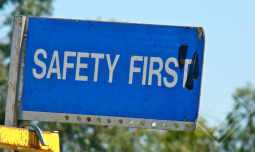
Great care is taken to inform all employees and visitors of the risks and dangers associated with trains and heavy equipment. Everyone must wear approved safety equipment when at the facility to include hard hats, safety glasses, steel toe boots, high-visibility vests, and hearing protection. In the various photos of this post you should see ample examples of the signs reminding all that safety is very important. I got the sense that, in fact, it is more important than the business which I applaud. Railroads and railroaders have a history and tradition of developing and applying safety measures within the industry and Union Pacific is no different.
Another element of safety that I found amazing was the overall cleanliness of the facility. Foreign objects and debris can be hazardous for employees and equipment alike. The Union Pacific takes great care in keeping the entire facility clean, free of debris, and orderly. In fact, UP even contracts with a street cleaning crew to maintain onsite street sweepers. This also helps to minimize environmental impact by helping to reduce dust. You can see the results for yourself in the accompanying photos.
Yellow is Green
According to a Union Pacific website, each ton-mile of freight moved by rail reduces greenhouse gas emissions by two-thirds, compared to transportation by truck.
Jim Young, Union Pacific’s Chairman and Chief Executive Officer, has defined UP’s Environmental Policy:
ENVIRONMENTAL POLICY
“At Union Pacific Railroad, we are committed to protecting the environment now and for future generations. Our employees, customers, shareholders and the communities we serve can expect our full compliance with all laws and regulations.
“Union Pacific is developing and investing in new technologies that provide for cleaner air and water, including a locomotive fleet that’s the greenest in the industry.
“Our employees understand that protecting the environment is part of every job, and they are creating and implementing world-class energy conservation techniques that are helping us to move more freight with less fuel.
“We will continue our leadership in caring for the environment while delivering the goods that America needs.”
The Union Pacific Railroad currently has two thirds of its road locomotive fleet certified under existing EPA Tier 0, Tier 1 and Tier 2 standards. They are currently replacing older, less efficient switcher-class locomotives around the UP system as well. Union Pacific is a leader in low-emissions and fuel efficiency testing and research.
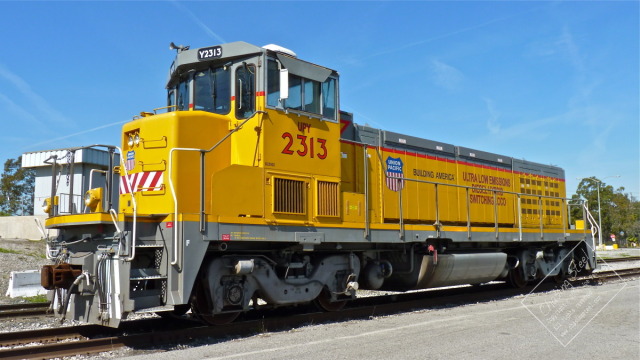 An example of an “ultra-low-emitting locomotive,” UPY 2313 (GG20GE), a Railpower GG20B “Green Goat,” basks in the sun while awaiting the next move of rail-cars around the ICTF. Unlike past operating procedures this switcher does not sit idling when not is use, reducing emissions even further.
An example of an “ultra-low-emitting locomotive,” UPY 2313 (GG20GE), a Railpower GG20B “Green Goat,” basks in the sun while awaiting the next move of rail-cars around the ICTF. Unlike past operating procedures this switcher does not sit idling when not is use, reducing emissions even further.
Operations
Currently, approximately 15 trains a day either originate or terminate at the ICTF complex daily. The facility operates 24 hours-a-day, 7 days-a-week and 365 days-a-year and employs approximately 500 employees.
The typical origination transfer routine calls for the containers to be unloaded from the huge container ships by massive dockside cranes. The containers are then loaded directly onto truck chassis and driven the 5 miles north to the ICTF. Once there, the trucks, drivers, and cargo undergo a robust security process prior to entering the facility and the truck is then assigned a parking space within the ICTF. The truck driver will drop off the chassis in its assigned location and return to the port to retrieve another container/chassis set.
Once the appropriate time comes to assemble a train and load the containers prior to the trains scheduled departure, a sufficient number of intermodal train cars, often referred to as “well cars” because of their shape, are to delivered to one of the 6 tracks within the ICTF designated for loading containers.
Next the containers that are assigned to depart on the train are retrieved from the parking area by yard tractors and loaded onto the rail-cars by large lift cranes called Mi-Jacks. It makes for a rather quick process as the entire team of dedicated professionals of drivers, crane operators, pin-setters, and safety officers are well-versed and perform in an orchestral fashion to ensure the operation is performed efficiently but safely.
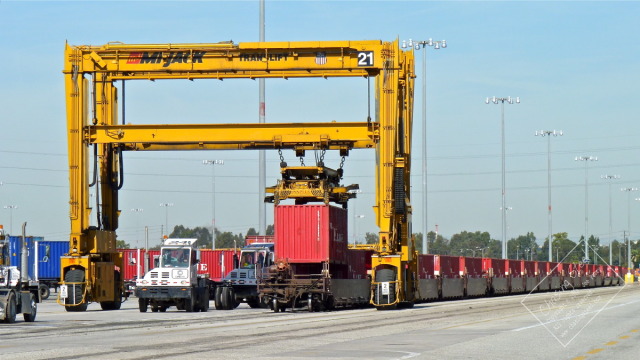 At ICTF, a stream of K-Line containers line up to be lifted onto well cars for departure to points east aboard this Union Pacific intermodal train.
At ICTF, a stream of K-Line containers line up to be lifted onto well cars for departure to points east aboard this Union Pacific intermodal train.
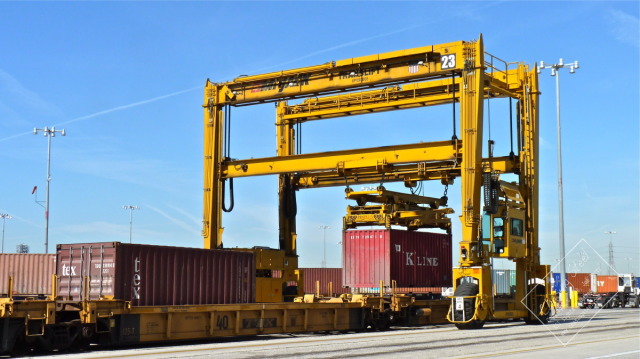 Mi-Jack #23, one of many, makes a lift of a container during the loading process of this intermodal train at UP’s ICTF.
Mi-Jack #23, one of many, makes a lift of a container during the loading process of this intermodal train at UP’s ICTF.
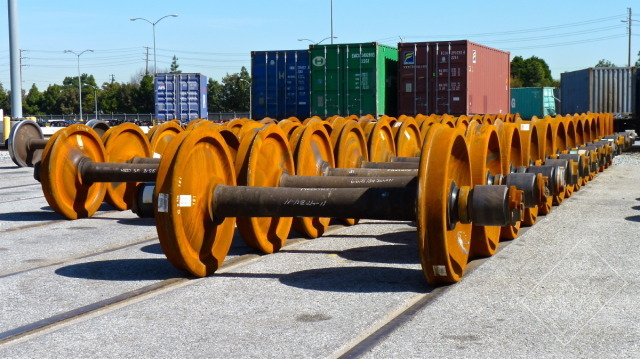 Spare wheel sets are staged ready to replace any bad wheel sets discovered during the inspections.
Spare wheel sets are staged ready to replace any bad wheel sets discovered during the inspections.
Supporting Facility
Located on the northern extremity of the ICTF is a key supporting player in the overall effectiveness of the ICTF - the Dolores Yard and Locomotive Facility. This rail facility contains approximately 10 yard tracks to store, make up, and break down trains originating or terminating in the south bay area, including the intermodal trains in and out of the ICTF. Another function of the Dolores facility is the onsite locomotive servicing and maintenance facility.
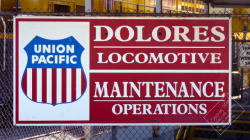
Intermodal trains terminating at Dolores or the ICTF will have their road units (locomotives) taken off of the train and serviced at Dolores. The locomotive facility performs inspections on the inbound locomotives, refuels the diesel tanks as required, fills the sand tanks in the locomotives, cleans the cab and performs other preparations to make ready the unit for its next run over the UP system. The facility can also perform minor repairs (called light repairs) to locomotives should a defect be found.
The location of the locomotive facility is ideal for UP’s intermodal activities because it is where the power for outbound trains comes from and ensures that there is ample power available for outbound trains. It also helps reduce emissions in the area because these locomotives do not have to be serviced at more distant facilities.
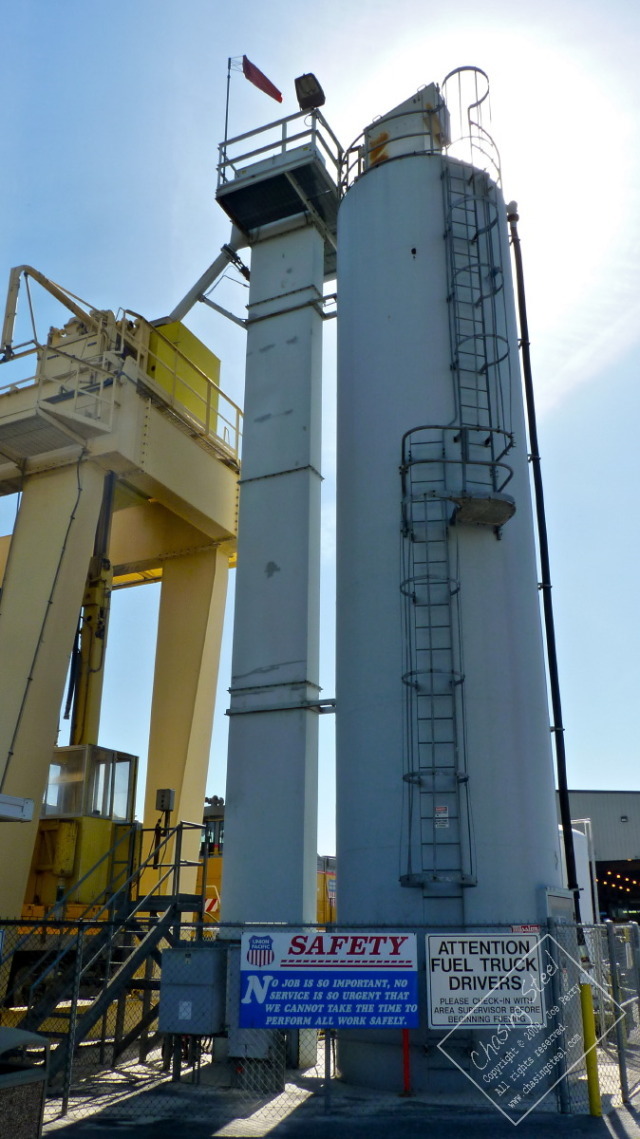 A sanding tower blocks the sun at the Dolores Locomotive Facility. Sand is used in locomotives to provide traction when required by laying sand on the rails for the wheels to grip.
A sanding tower blocks the sun at the Dolores Locomotive Facility. Sand is used in locomotives to provide traction when required by laying sand on the rails for the wheels to grip.
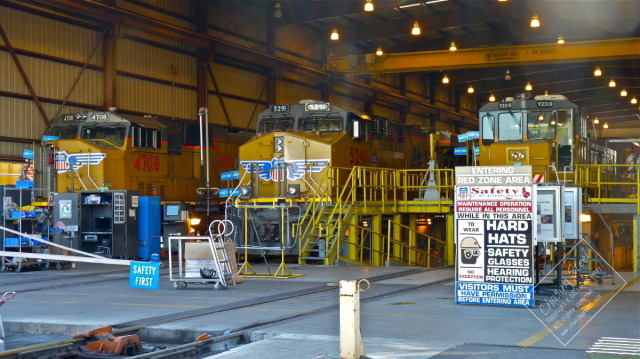 The three track inspection and servicing bay at the Dolores Locomotive Facility helps reduce costs, time, and emissions.
The three track inspection and servicing bay at the Dolores Locomotive Facility helps reduce costs, time, and emissions.
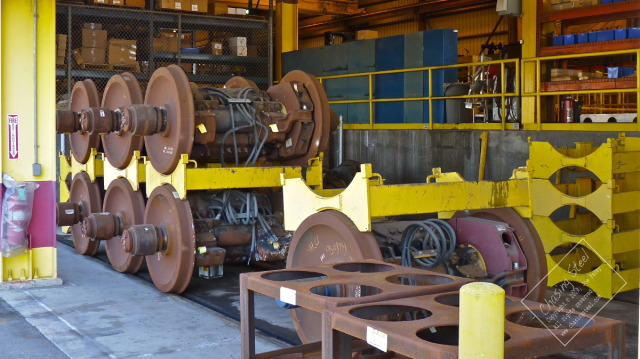 Traction motors are staged, ready to go into service should a unit have a faulty traction motor. Traction motors are the wheel sets that actutally provide the tractive effort to move a locomotive. They are massive electric motors that rest on top of the locomotives wheel sets.
Traction motors are staged, ready to go into service should a unit have a faulty traction motor. Traction motors are the wheel sets that actutally provide the tractive effort to move a locomotive. They are massive electric motors that rest on top of the locomotives wheel sets.
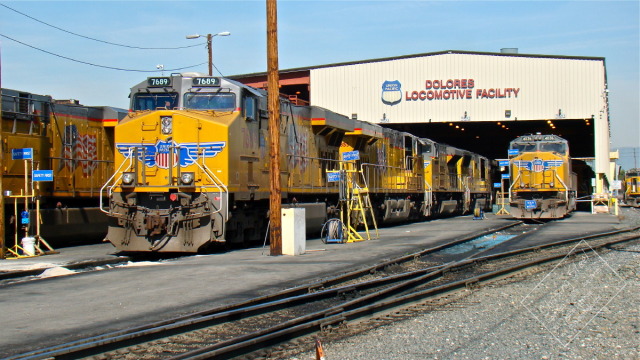 Units wait to be serviced, repaired, or returned to duty at the Dolores Locomotive Facility in Long Beach, CA.
Units wait to be serviced, repaired, or returned to duty at the Dolores Locomotive Facility in Long Beach, CA.
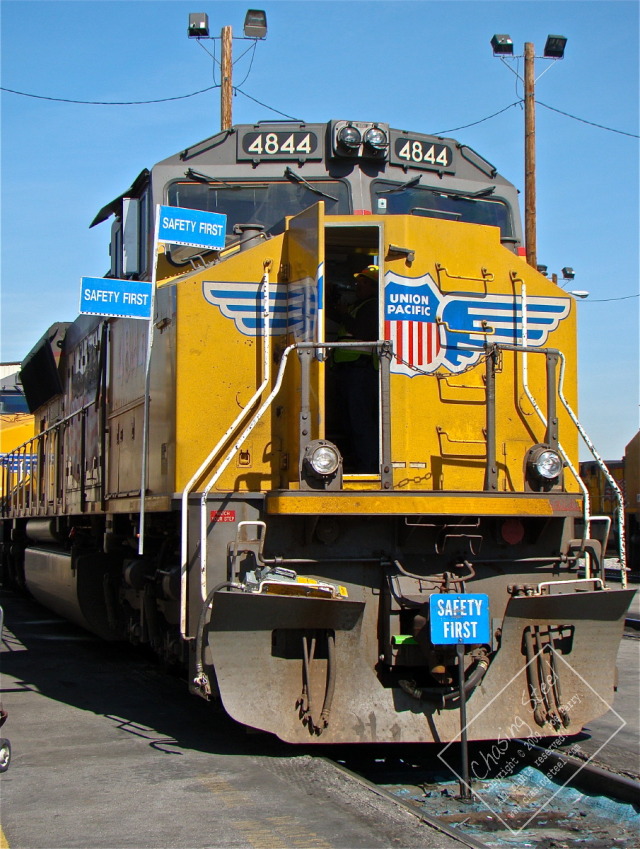 UP 4844 (EMD SD70M), built 11/2002, gets an inspection and light repairs at the Dolores Locomotive Facility before returning to revenue service.
UP 4844 (EMD SD70M), built 11/2002, gets an inspection and light repairs at the Dolores Locomotive Facility before returning to revenue service.
Better and Greener
In December 2007, Union Pacific submitted and application for a modernization plan of the ICTF to the JPA. The plan, based on increased projected traffic levels and measures to improve efficiencies, is currently under review while the various impact studies are performed. If the plan is approved, Union Pacific will begin a 3 to 4 year effort to double the facility’s container handling capacity while making even more strides to reduce emissions, noise levels, and ambient light cast, and REDUCE the size of the complex from 233 acres to 177 acres. The application and plan details can be reviewed here.
Conclusion
The ITCF, and the Dolores facility, is an impressive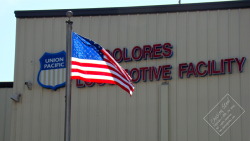 complex where the pride and skill of the workforce serves an example of the efficiency and safeness of America’s rail transport infrastructure. The men and women of the ICTF, along with the management of Union Pacific, should be proud of the work and service they perform there day in and day out to help keep America moving forward and doing their best reduce any impacts on the environment - something we all need to do.
complex where the pride and skill of the workforce serves an example of the efficiency and safeness of America’s rail transport infrastructure. The men and women of the ICTF, along with the management of Union Pacific, should be proud of the work and service they perform there day in and day out to help keep America moving forward and doing their best reduce any impacts on the environment - something we all need to do.
 Conduct,
Conduct,  Special Agent,
Special Agent,  Special Agent Phillips,
Special Agent Phillips,  Union Pacific Railroad CATEGORIES:
Union Pacific Railroad CATEGORIES:  Editorial,
Editorial,  Media
Media 




